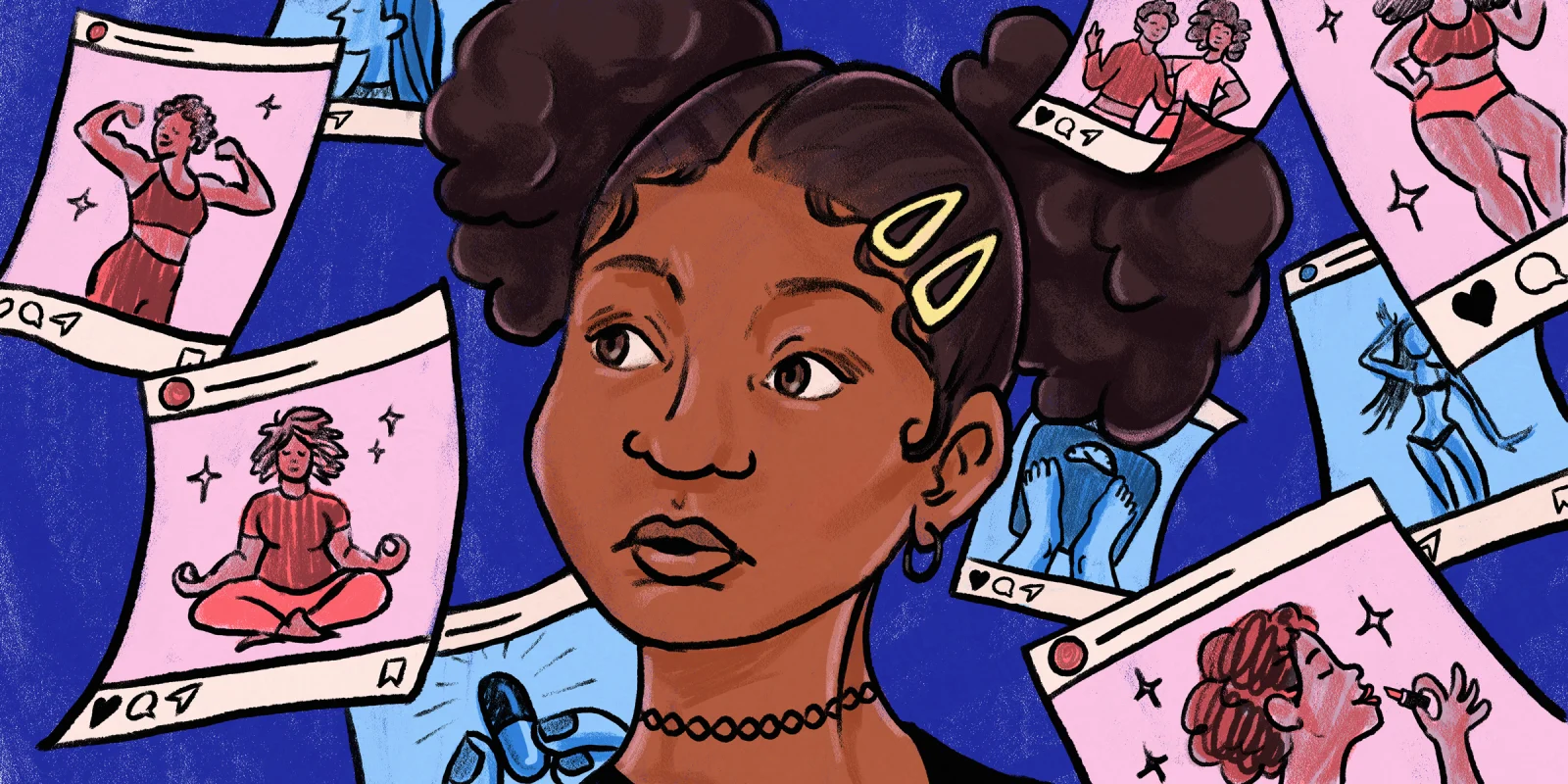It’s 5 o’clock after a busy clinic day. I’ve just wrapped up my last patient visit, a teenage girl of color I saw for a well-child exam. The appointment began as they often do: with introductions and pronoun identification, followed by standard health questions that are often answered with a barely audible, “I dunno” and the casual teenage eye roll. Because of where most adolescents are developmentally, and the importance of confidential care to help facilitate disclosure of certain risk behaviors, aspects of the office visit often take place with the caregiver outside of the exam room.
“Are you on social media?” I’d asked.
“Yes, who isn’t?” she replied. “I only use Instagram though.”
“Oh, are there certain accounts that you follow or like more than others?” I asked.
“Well, I follow accounts to look like a certain body type and use them for weight lifting at school.”
“How do you feel about your body?”
“I like my body because I’m not too thin or too fat. I have curves like the people in the accounts I follow."
I’m rarely able to anticipate what a patient might share during our conversations. However, for my teenage female patients of color, use of social media as a tool to achieve a particular body type has become an increasingly common theme. Recently, another Black teenage patient of mine shared that she was using a supplement she had seen on Instagram to “detox” because she was “too fat.”
In a perfect world, social media developers, as well as caregivers, would share the responsibility of thoughtfully filtering harmful content on platforms like Twitter, Facebook, YouTube, Instagram, Pinterest, Snapchat, and TikTok to protect teenagers. Instead, all too often, the approach to teenage social media use is haphazard, thoughtless, and complicated by the fact that some believe social media is a remedy for social isolation. In fact, a study by the University of Pittsburgh found that teens who use social media heavily are three times as likely to feel socially isolated. Additionally, social media platforms frequently use algorithms to curate user content, which may further contribute to harmful exposures for youth. Algorithms often use personal data to operate in a way that amplifies certain content over others. They often use sensitive user information like geographic location and friends most interacted with, which may lead to privacy concerns. “Information gaps” may arise as a result of algorithms as certain posts may be hidden while prioritizing revenue-generating content which often leads to a non-objective decision of which artists, content creators, or brands deserve more attention. These highlighted content in the interest of monetary gains does not always align with what might be positively influential for more impressionable social media users.
Technology has also made content that used to exist only in print subscriptions (e.g., “Teen Vogue”) more accessible, and a growing number of “influencers” (individuals who make a living by marketing a “lifestyle” of wellness) are distributing #bodygoals that are often toxic and unrealistic. Facebook recently came under fire for knowingly ignoring evidence that Instagram (owned by Facebook) harms young girls’ mental health and perceptions of their body image. This effect may be compounded for young Black females who often also struggle with not seeing themselves reflected and broadly accepted in mainstream media. A study conducted at Yale School of Medicine demonstrated, for example, that Black teen girls using platforms like Twitter and Snapchat to navigate dating often experience “racism and bias, such as being associated with Black stereotypes, cultural invalidation, and being accused of ‘acting white.’” Many Black teen girls also believe that their hair type or skin tone isn’t valued because mainstream narratives perpetuate white normative beauty standards. Coupled with the fact that unrealistic standards of beauty are marketed as “wellness,” it’s no wonder teens are experiencing adverse effects.
During the COVID-19 pandemic, there has been an uptick in office appointments, inpatient admissions, and ER visits for depression, anxiety, and suicidal ideation amongst teens. The cause is likely multifactorial, but it is evident that social isolation and a lack of real-world peer interactions has played a major role. Not surprisingly, screen time amongst youth doubled outside of virtual school from an average of 3.8 to 7.7 hours per day. The Adolescent Brain Cognitive Development Study found that children of color and from lower income families “logged more hours on screens than their white, wealthier peers.” Social media usage also increased significantly over the past year in the same age group, which may be further contributing to feelings of social isolation.
For Black teens, mental health has been particularly impacted by widespread access to viral videos of police shootings. When a group of African American and Latinx adolescents viewed traumatic events online, they had higher rates of depressive and post-traumatic stress symptoms, including re-experiencing, avoidance, numbing, and hyperarousal. Each incident might serve as a reminder to Black youth that, in this country, their lives have been devalued. In light of data showing that social media causes the most harm for teenage girls, Black teen girls are even more at risk by virtue of their intersectional identities.
Intentionally counteracting the negativity of social media’s influence regarding body image, self-esteem, and self-worth — particularly for Black teen girls — is crucial. There are several positive social media hashtags (e.g., #BlackGirlMagic, #BlackGirlsRock. and #BlackIsBeautiful) that empower and encourage Black girls to actualize their self-worth by taking pride in their heritage and culture. In a survey of young Black women on Instagram, 82% of respondents believed that the #BlackGirlMagic social media movement had an impact on their self-esteem, with 69% reporting improved self-esteem after hashtag interaction.
When my Black teen patient shared that she had tried detoxing to change her body, I thanked her for trusting me with her experience and then pointed to the pin I wear on my badge: “Black Excellence.” We bonded over discussing what Black Excellence meant to each of us, and talked about #BlackGirlMagic and how viewing ourselves through the lens of self-love and positive body image helps us accept our uniqueness. She smiled at the end of our conversation, lifting her head a bit higher.
How do you seek opportunities for meaningful interaction, particularly with patient populations that are especially vulnerable?
Dr. Thelben Mullett is a board-certified pediatrician who completed her medical training at the University of Illinois College of Medicine and pediatric residency at the University of Washington. She's an outspoken advocate for child health, social justice, and anti-racism. She has developed EDI curriculum focused on addressing health disparities at the graduate medEd level. She's also an avid writer and also publishes short essays on Medium. Dr. Mullett is a 2021–2022 Doximity Op-Med Fellow.
Illustration by Diana Connolly







